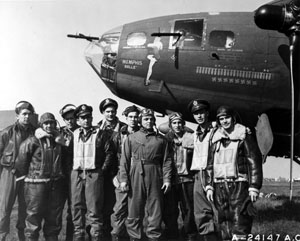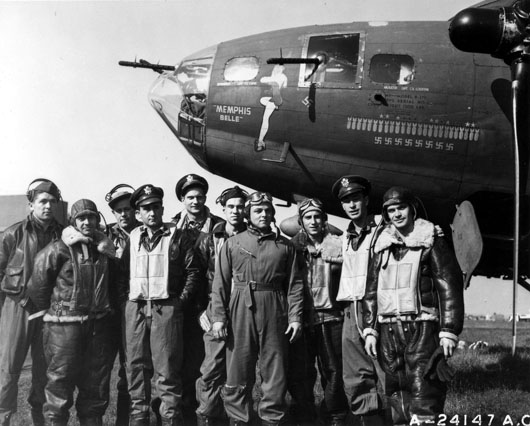
Jo Condra of Springdale, now 94, was one of those girls.
Condra was surprised 67 years ago to find out that her husband, 1st Lt. Paul T. Condra, had christened his B-24 bomber “Arkansas Joe.”
She was surprised again in December, when an image of “Arkansas Joe” ran in the Arkansas Postcard feature of the Arkansas Democrat-Gazette.
But Paul Condra has never been far from his widow’s thoughts. Photos on the bedroom wall of her Springdale home remind her of the day he and his colleagues posed in front of a B-17 to celebrate their commissioning as first lieutenants and of the B-29 he was flying when the young couple lived in Albuquerque, N.M., at the end of the war. An image of “Arkansas Joe” hangs there, too.
“It’s the only airplane I ever had named after me,” she said with a chuckle.
“During a mission over eastern Europe in April 1944, ‘Arkansas Joe’ took heavy flak damage that killed the bombardier, Lt. Bud Ackerman, my stepfather’s close friend, and wounded my stepfather,” Condra’s son, Jim Morriss, former executive editor of The Springdale News and The Morning News, picks up the story. “Lt. Condra and his copilot brought the four-engine plane back to base on 1 1/2 engines. Lt. Condra was returned to the U.S. and mostly recovered from his wounds. He carried flak in his body until he died.
“A crew member I met in the 1980s stayed with the plane for several missions, then was transferred to another crew,” Morriss adds. “He survived over 35 missions and eventually saw the former ‘Arkansas Joe’ (the new pilot changed the name) crash into the Adriatic Sea.”
After Paul was discharged in 1946, the Condras moved back to northwest Arkansas and opened an auto parts store in Springdale in February of that year. When Paul died in 1956, Jo took over and ran the store until 1986.
“It sort of became my home,” she said. “I went down there at 5 in the morning and stayed until 5 or 6 in the evening. (The mechanics) weren’t just my customers, they were my friends.”
Needless to say, selling the store didn’t work out for Condra.
“I had been retired for about three months when I began wishing I hadn’t done it,” she saids. It wasn’t long before the buyer, Crow-Burlingame Co. of Little Rock, doing business as Bumper to Bumper, asked her to work part time.”
“The day I went back was one of the happiest days of my life. It’s what keeps me going.”
Condra still works five afternoons a week. Few people know that she was immortalized as “nose art,” but she admits she was “thrilled” to see the image of “Arkansas Joe” in print.
“War is horrible,” she said. “But it brought back a lot of good memories.”
World War II was the golden age of nose art, says Larry Decuers, a curator at the National World War II Museum in New Orleans.
“It just wasn’t good luck to have a plane that wasn’t named,” he said. “When you were made a pilot in 18 months and became commander of an aircraft, in charge of 10 men, it was nice to have some things from home – like nose art.
“And it was a way for people to express some individuality in the military culture.”
“During World War II, Americans produced 237,000 airplanes. Of those sent overseas to the various war theaters, it would be safe to say that over 90 percent would have some type of painting on the nose,” said Jeff Wood, director of the American Airpower Heritage Museum in Midland, Texas.
“Centerfolds were very popular in that time period,” he went on. “Most nose art paintings were done for $50 or a bottle of scotch by anyone who had any drawing ability whatsoever,” but many of them were modeled on the popular Esquire centerfolds created by Alberto Vargas.
So while the planes’ names paid tribute to wives and girlfriends at home, the images weren’t always based on those women.
“Some are almost like a stencil right out of the magazine,” Wood said, “and others were modified to suit their idea of what they wanted on the side of their aircraft. It was a little bit of both.”
Nowadays, he says, only patriotic images are permitted on U.S. planes, but during World War II, girls weren’t the only inspiration for nose art. Cartoons, political figures, “a whole gamut of imagery was popular.”
The American Airpower Heritage Museum, operated by the Commemorative Air Force, has the largest collection of original World War II nose art in the world – coincidentally preserved by Minot Pratt of Walnut Ridge, Ark.
“Right after World War II, the military realized the country didn’t need and couldn’t support all those aircraft,” the museum’s director explains. Decommissioned planes were sent to five different military bases, and bids were accepted for salvage rights.
Pratt was general manager at the Aircraft Conversion Co. owned by George R. and Herman Brown in Walnut Ridge, Ark., and he had his crews chop out and save 34 pieces of nose art, thinking he’d mount them on a fence along the highway. His son, Tully Pratt III, donated them to the Commemorative Air Force in the 1960s.
“For some time, they were stored in an open-air hanger in Harlingen, Texas,” Wood says, and suffered serious damage from salt air. A campaign to “Save the Girls” paid for the images to be stabilized, and they’re now the centerpiece of the 100,000-artifact collection at the Midland museum.
They’re not only American folk art, Wood says, but a lasting memorial to the bomber crews of World War II and the artists who painted the images.
Nose art was also immortalized on leather jackets worn by servicemen, adds Decuers of the National World War II Museum. The New Orleans collection includes 10 examples.
And the United States wasn’t the only nation that allowed nose art. The Ozark Military Museum has one plane bearing nose art – and it’s Canadian.
“Hardly a plane in World War II escaped without having nose art,” said Leonard McCandless, director of the Ozark Military Museum. “It meant a lot to the pilots.”
It means a lot to those who remember, too.
___
Information from: The Springdale Morning News,
http://www.nwaonline.com
Copyright 2011 Associated Press. All rights reserved. This material may not be published, broadcast, rewritten, or redistributed.
AP-CS-01-22-11 1706EST
ADDITIONAL IMAGE OF NOTE


